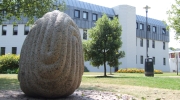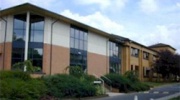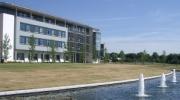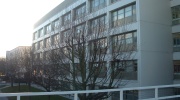Contributing Departments
The University of Warwick is a research intensive university and research of the highest quality has been a major focus since its inception in the 1960s. It is commonly ranked 4th among the UK's 100 Universities for quality of research. It has generated numerous spin-off enterprises.
 |
Warwick Systems Biology Centre and Systems Biology DTC Two new centres also working at the Life Sciences Interface. They share the top floor of Coventry House with MOAC. |
|
|
Mathematics Institute and Department of Statistics Generally regarded as two of the UK's top mathematical science departments. They maintain a high level of activity across an increasingly broad range of the mathematical sciences with a post-graduate community of 125 students. The applied mathematics group at Warwick is one of the strongest and most outward looking in the UK and received a 5*A rating in the 2001 RAE. Through its interdisciplinary programme MIR@W the Warwick department has played a leading role in developing multidisciplinary research outside the traditional disciplines. Through this and its Mathematics in Medicine Initiative (MiMI), it has considerable experience of highly successful interaction with biologists and clinicians. There is very strong interaction between Applied Mathematics and the Department of Statistics which also received a 5* rating in the 2001 RAE. Common interests include several areas of importance for MOAC such as stochastic differential equations, theory and applications of Monte-Carlo Markov chains, time-series analysis and Bayesian statistics. |
|
|
An extremely active department with approximately 35 postdoctoral fellows and 80 graduate students together with 30 fourth year MChem students; it received a 5A rating in the 2001 RAE. The department contains a wide range of equipment: 5 high field NMR spectrometers, X-ray diffractometer, 13 research grade mass spectrometers (EI, CI, FAB, MALDI-TOF, ESI, FT-ICR MALDI, and 9.4T FT-ICR ESI instrument facility), an analytical suite (ICP, FTIR, UV-Vis, CD, LD, TGA, DSC, microanalysis, HPLC, MPLC), AFM, STM, computational modelling etc. The biophysical chemistry activity of the department has a focus on instrumentation design and development for structural characterization of biomolecules complemented by molecular modelling. Access to SEM, TEM, Squid magnetometry and solid state NMR (600 MHz) is by continued collaboration with the Physics department.
|
 |
Consistently rated among the top Biology departments in the UK with a 5-rating in every RAE exercise conducted to date. It has significant strengths in molecular biology, cell biology, microbiology, virology, structural biology and epidemiology and comprises 60 academic staff, 20 research Fellows, 50 post-doctoral researchers and 70 support technical staff. It has a substantial postgraduate population (over 100) and is one of only seven UK Departments to be awarded a BBSRC Doctoral Training Account (10 PhD studentships per year for 5 years), reflecting the extensive BBSRC funding awarded to the department and its excellence in graduate training. It has a strong structural biology group that will support the MOAC programme. |
 |
The goals of this newly-established centre are to facilitate computationally driven research of the highest calibre throughout the sciences and engineering; to foster inter-disciplinary research through the sharing and development of algorithmic expertise; and to spearhead graduate-level training in scientific computing. The joint posts between CSC and Departments in the Science Faculty include molecular modelling, theoretical biology, complex fluids, and medical image processing. This influx of expertise and the existing links gives a unique opportunity to provide training in computational methods in a multi-disciplinary environment and the CSC provides the perfect vehicle to provide MOAC members with computational skills of the very highest calibre. MOAC students will have access to high-performance parallel computers and graphics workstations. The CSC and the Department of Computer Science are active participants in the UK Computational Grid. This combination of ongoing collaborations and shared facilities represents a perfect platform on for a DTC with high-quality training and research at the Life Sciences Interface.
|
 |
The Department of Physics at Warwick has an international reputation for its research across a wide range of modern physics. It was rated as an internationally-prominent (5A) department in the 2001 Research Assessment Exercise. Its research is well supported by a wide range of funding bodies and involves many collaborations worldwide. Research in the department has many uses, providing a focus in the UK and the region in its areas of expertise, attempting to answer some of the fundamental questions of nature, and creating wealth through its interaction with industry. Research activity ranges from areas with a key interest in MOAC, such as Theory, Simulations and NMR of Biological systems to Condensed Matter Physics, Astronomy, Space & Fusion Plasma Physics and Elementary Particle Physics. There is much overlap between these areas, as well as collaborations with physicists elsewhere. It has numerous interdisciplinary and multidisciplinary links, including many that lie within the MOAC theme, within the university, in the UK, in continental Europe and worldwide. |


